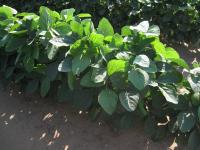Contact
For more information, contact your local county Extension Agent.
Planting & Maintaining a Vegetable Garden
Before you begin planting be sure to:
![]() Plant perennial crops such as asparagus and strawberries over to the side of the
garden since they will remain in the same area for many years.
Plant perennial crops such as asparagus and strawberries over to the side of the
garden since they will remain in the same area for many years.
![]() Put all tall growing crops together where they don't shade out low growing crops.
Put all tall growing crops together where they don't shade out low growing crops.
![]() Follow quick growing, early spring crops with warm season crops during the late spring
and summer.
Follow quick growing, early spring crops with warm season crops during the late spring
and summer.
Planting Dates
- Planting Dates for Spring and Summer Vegetable Production
- Planting Dates for Fall Vegetable Production
Planting Tips
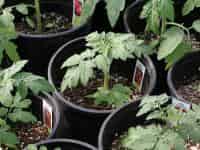 The use of transplants shortens the period to harvest and allows the gardener to complete
a crop before it gets too hot or cold.
The use of transplants shortens the period to harvest and allows the gardener to complete
a crop before it gets too hot or cold.
- In the spring we often go from too cold to too hot for plants such as tomatoes. Transplants
will grow in soil that is too cool for seed to germinate.
- In the fall we may use transplants because of delays caused by summer crops not being mature when cool season crops need to be planted.
How do I transplant successfully?
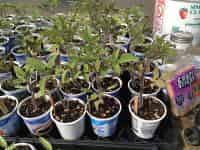
![]() Choose quality transplants with good root volume.
Choose quality transplants with good root volume.
![]() Always remove plastic, or paper pots from transplants and crack peat pots to allow
roots to grow easily and unrestricted into the soil.
Always remove plastic, or paper pots from transplants and crack peat pots to allow
roots to grow easily and unrestricted into the soil.
![]() Starter solution helps plants grow quickly by providing nutrients to the plant quickly.
Make a solution by mixing one tablespoon of a soluble fertilizer such as 10-20-10,
in one gallon of water. Pour 1 cup of this solution around each plant as you set it
out.
Starter solution helps plants grow quickly by providing nutrients to the plant quickly.
Make a solution by mixing one tablespoon of a soluble fertilizer such as 10-20-10,
in one gallon of water. Pour 1 cup of this solution around each plant as you set it
out.
![]() You can grow your own transplants by starting seed three to eight weeks prior to
planting in the garden. Green beans and cucumbers are ready to plant in three weeks,
while tomatoes and peppers take six to eight weeks to grow a transplant.
You can grow your own transplants by starting seed three to eight weeks prior to
planting in the garden. Green beans and cucumbers are ready to plant in three weeks,
while tomatoes and peppers take six to eight weeks to grow a transplant.
![]() Some vegetables such as tomatoes, peppers, eggplant, cabbage, broccoli and cauliflower
should be transplanted as small plants rather than planted as seed.
Some vegetables such as tomatoes, peppers, eggplant, cabbage, broccoli and cauliflower
should be transplanted as small plants rather than planted as seed.
To learn about plant propagation download Plant Propagation for Home Gardeners
- In general, small seed like those of lettuce, mustard, radish or turnip should be
planted about 1/4 - 1/2 in. deep.
- Large seed such as beans, squash, pumpkin and corn can be planted deeper 1 to 1 1/2
in deep.
- Spacing of vegetables will be different with various cultivation methods. Tractors need wide rows. Rows in small gardens may be placed close together since weeding may be done by hand. To ensure a good stand, it is often better to plant seed thickly and thin later.
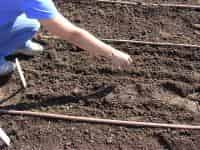
However, seed is normally expensive and should not be wasted. Plan carefully and only buy seed that is needed. If seed is left over, put it into a dry container and refrigerate for use later. Gardeners may be successful in using one-year-old seed, but old seed loses strength. Germination tests will not indicate seed strength, which is sometimes called "vigor."
Use of good seed is very important. Buy only from dealers who have a reputation for handling good seed. Saving vegetable seeds grown in Arkansas is not a good practice. Many vegetable diseases are transmitted through seed and planting diseased seed often results in severe losses.
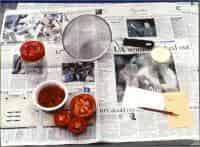 Saving seeds is a way to preserve unique cultivars of vegetables from one year to
another. Save seed from non-hybrid cultivars to maintain genetic purity.
Saving seeds is a way to preserve unique cultivars of vegetables from one year to
another. Save seed from non-hybrid cultivars to maintain genetic purity.
Self-pollinated vegetables such as tomatoes, peppers, beans, peas, and lettuces are the easiest plants to save seed from because they do not require isolation from other plants.
Some vegetables have a short harvest season. If only one planting is make, these vegetables
will be available for a limited time.
Two or three plantings of these crops may be made a week or 10 days apart. This gives a much longer harvesting period.
Some of the crops that have a short harvest period are radishes, leaf lettuce, spinach, bush snap beans, green onions and sweet corn.
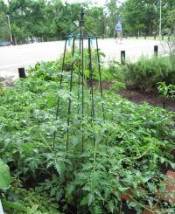
Tomatoes and peppers are usually grown with cages or stakes to keep them elevated.
Poles, fencing panels, and towers are used for elevating cucumbers, gourds, squash, small melons, and pole beans.
Maintaining Your Vegetable Plants
Site selection and soil preparation are both important to produce favorable yields but so is maintenance and care.
Watering is important for the garden and is critical to producing quality vegetables.
When irrigating your garden thoroughly, wet the soil at least once a week unless there is sufficient rainfall to moisten the soil around the roots. One inch of water will usually moisten the soil to a depth of 5-6 in. A light sprinkling of water every day only wets the soil surface and encourages shallow root development, which is undesirable.
For home irrigation tips, go to our page Irrigation for Home Gardens
Mulches can help control loss of moisture from the soil, weeds and plant diseases. A mulch is anything that acts as a barrier between the plant and the soil and can be anything from plastic film or landscape fabric, to newspaper or craft paper.
There are lots of mulch options. Spread down newspaper, shred your junk mail and lay that down. It doesn't have to be as aesthetically pleasing in the vegetable garden as it does in ornamental beds. Mulching a large garden may seem like a lot of work on the front end, but the amount of weeds it will cut down will make it worth the effort.
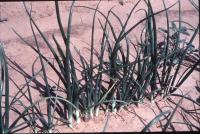
Lettuce, onions, and beets should be thinned to allow the remaining plants to grow and properly develop.
Integrated Pest Management (IPM)
"Pest" can mean insects, pathogens causing plant disease, and weeds that cause economic damage to crops.
Insect control in the vegetable garden requires an integrated effort using, cultural, mechanical and chemical methods of insect control. This is often referred to as integrated pest management (IPM).
Identification of insect pests is key to treatment. By knowing the biology of both the host and the pest, insect problems can be avoided or reduced. Sometimes just picking off the eggs or the larvae will control the insects. Learn how to implement an IPM program for insects.
Need help identifying a pest?
Gardeners use a number of tools to control both biological and physiological plant diseases. Like insect control, this is also IPM.
Cultural methods should always be the first line of defense against diseases. Genetic resistance, crop rotation, use of mulches , use of cages, and minimizing the time free water is on the plant will help to avoid or control diseases.
Controlling plant diseases during the growing cycle, harvesting at the proper stage, and using the proper storage conditions will allow the gardener to enjoy certain vegetables for many weeks after they are harvested.
Need help identifying a plant disease?
Weeds compete with vegetable plants for water, sunlight and plant nutrients. Destroy them so that the vegetables develop properly. Weed control in the vegetable garden requires a coordinated effort using cultural, mechanical and chemical methods.
- Hoeing is the safest and most effective way to control weeds in the vegetable garden. While there are some herbicides that are labeled for gardens, they are usually not
recommended for all vegetables, and the waiting period may be too long for you to
use.
- Hoeing is actually preferable to the tiller. Tilling is easier, but actually brings
up more weed seeds from down below, which leads to more weeds.
- Cutting the weeds off at the surface and then mulching is an effective way to prevent the growth of most weeds, except nutsedge.
- Cover crops and crop rotation will help to prevent the build up of a weed seed population.
Generally, practice shallow cultivation. After a vegetable plant has obtained good size, many of its roots are in the upper two inches of soil. Deep cultivation injures roots and decreases growth and yield.
For more info:
download MP44 Recommended Chemicals for Weed and Brush Control
Check out our Q & A on Weeds
For more pest management resources explore our section:
Arkansas Pest Management - Insects, Weeds, and Plant Diseases
